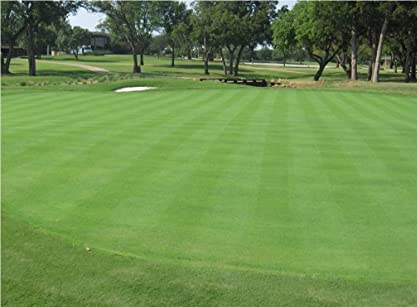Pencross Bentgrass is known since 1955 by the scientific name “Agrostis stolonifera”. It comes from a family of Poaceae. Penncross is creeping bentgrass that Penn State University introduced. Penncross’ vitality and damage tolerance have made it the most extensively utilized creeping bentgrass in the golf industry. Penncross has a dark green turf that has good heat and cold tolerance. The Penncross Bentgrass is known for its upright growth features, fine leaf texture, and wide range of adaptability.
Penncross is heat and cold tolerant, and it may thrive in a variety of temperatures in the West. Penncross has a low shade tolerance. Penncross requires adequate drainage and loves a somewhat acidic soil with the good moisture-holding ability to perform at its best. Salty soil or water may be a limiting issue in the proper growth of Penncross.
Pencross Bentgrass is considered to be the most beautiful of grasses, with its tight, upright growth habit and delicate leaf texture. It is a luxury cool-season grass with rich bluish-green color, thick density, and low growing habit. Bentgrasses are disseminated by their long creeping stems that are extended above the surface of the soil.
Penncross Bentgrass identifications
Knowing how to distinguish creeping bentgrass from other weeds or grasses is essential, as each has its own set of treatment options.
Creeping bentgrass can be identified by:
- Lighter-colored patches appear initially, ranging in size from 6 inches to 2 feet.
- Turning brown and wilt during summer.
- During the summer, the grass will eventually turn brown and wilt.
- A horizontal expansion trend.
- A deep root system.
- Being resistant to raking.
Penncross Bentgrass Seed
The Penncross Bentgrass is grown by the seeds which are kept moist until they found an appropriate root system. The seed of Penncrosss Bentgrass is kept at a depth of 1/4 inches. The germination of the seeds depends upon the temperatures of the soil. The seeds can be germinated within 7-15 days. The mowing of the Penncross Bentgrass takes place after 30 days of proper germination.
For Penncross Bentgrass to germinate, it needs good drainage, good soil, good PH, and good soil temperature, as well as perfect weather conditions.
Penncross Bentgrass Uses
Penn Cross Bentgrass is ideal for golf course fairways, tees, and greens, as well as winter Bermudagrass greens, overseeding.
PennCross Bentgrass thrives in sandy soils and may withstand clay soils with proper drainage. PennCross, on the other hand, can withstand moist soil conditions for short periods, whereas bentgrasses do not. This perennial creeping grass is native to Asia and Europe and is used alone or as part of a seed mix for golf courses, home lawns, and fields.
The varieties of Bentgrass cultivars such as Penneagle, SR1020, Crenshaw, Penn Links, Cato, and Emerald are utilized as a seed mix for the golf course and different fields.
Penncross Bentgrass Maintenance
Creeping bentgrasses demand a thorough turf management approach that begins as soon as they are established. The success of bentgrass golf greens in the South is dependent on intensive maintenance and frequent observation. Penncross Bentgrasses are kept green during the summer by carefully monitoring the following processes:
- Watering
- Fertilization
- Mowing
- Cultivation
- Watering
- Infestations.
Mowing the grass, fertilizing, and applying fungicides to prevent the spread of fungi, and insecticides to keep hazardous insects at bay are all part of long-term Bentgrass management. This grass also necessitates careful watering and aerification every year.
Water must be carefully controlled to meet the moisture requirements of the grass while not preventing oxygen from reaching the soil. During times of heat stress, water also helps to keep the temperature down. During the summer, bentgrass success or failure may be determined by watering habits.
On bentgrass greens, fertilization is also important. The successful manager strategically applies fertilizer to stimulate growth while preserving carbohydrate reserves. The fertilizers are applied in small amounts between June and September. A total of 5 pounds of nitrogen is applied per year. The quantity of nitrogen is distributed monthly in the following manner:
- 0.5 pounds per 1,000 sq. ft. from October to May.
- 0.25 pounds per 1,000 sq. ft. from June to September
Frequent surveillance is required to successfully control pest and disease issues. The following pests can be discovered in the Penncross Bentgrass if not maintained properly:
- Sod Webworms.
- Cutworms.
- Mole Crickets.
- White Grubs.
All these pests must be treated immediately after being discovered.



